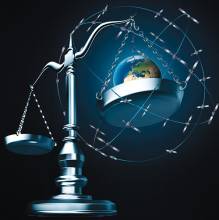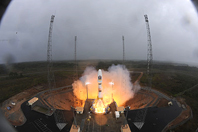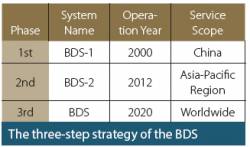Global navigation satellite systems have become core elements of the global economy. Essential for many civilian applications and innovations, GNSS brings rapidly growing economic benefits due to convergence of GNSS with smartphones, geospatial data, unmanned aerial vehicles, automated driving systems and other commercial technologies.
Global navigation satellite systems have become core elements of the global economy. Essential for many civilian applications and innovations, GNSS brings rapidly growing economic benefits due to convergence of GNSS with smartphones, geospatial data, unmanned aerial vehicles, automated driving systems and other commercial technologies.
According to the most recent European GNSS Agency (GSA) GNSS Market Report issued earlier this year, 3.6 billion GNSS devices were in use globally in 2014. By 2019, this number is forecast to increase to more than seven billion, an average of one device for each person on the planet.
The GSA estimated the global revenue for GNSS devices, components, software, and services to be roughly €62 billion in 2014, while revenues from applications brought in an estimated €227 billion. More than 90 percent of that revenue will come from location-based services (LBS) and road transport systems and applications.
Meanwhile, the U.S. Department of Homeland Security counts GPS as having a crucial role in 14 of the 16 industries that are classified as part of the national critical infrastructure. Both the U.S. and the European Union (EU) may consider designating the systems themselves as critical infrastructure.
GNSS has become so convenient and ubiquitous that users tend to treat its services as a given. However, these highly complex systems are vulnerable to such things as space weather, jamming, and spoofing, and the deployment, maintenance, and protection of GNSS requires significant public resources.
Delays in deployment or modernization, launch failure, or individual satellite failures may decrease the availability and performance of GNSS signals and services. In the great majority of cases, the degradation or loss of GNSS signals and services will cause only individual or local inconvenience, but the possibility exists for wider failures with more serious consequences.
Although it is currently rare for safety-critical systems to rely wholly on GNSS, related services that are otherwise independent may have GNSS as a common point of failure. The question thus arises whether users of GNSS or third parties may claim compensation for damage suffered from reliance on malfunctioning GNSS systems.
This article presents an overview of the discussions at international level and the specific status within the European Union for the Galileo system.
GNSS Liability — a European Problem?
For a long time, responsibility of GNSS owners and operators for malfunctioning of the systems was not a major topic of discussion. Due to the military nature of GPS and GLONASS, the U.S. and Russian governments denied any responsibility for the performance of signals and services provided by the systems. As the open signals are provided free of charge, there is no contractual liability which could be evoked. Non-contractual liability is limited by the doctrine of sovereign immunity and any applicable national laws regarding state liability.
The situation changed with the advent of the European Galileo system and the accompanying promise of providing a set of highly accurate, guaranteed global positioning services under civilian control. As a core differentiator to the other GNSSes, Galileo intends to offer a Commercial Service (CS) subject to usage fees and based on contractual relations between the GNSS operator, the future providers of the service, and the users.
In contrast to the other GNSSes, operations, maintenance and signal provision will not be conducted by the military, but by an industrial service operator selected under public procurement procedures. While the initial concept of a concession failed in 2006, the European GNSS Agency (GSA) currently runs a procurement procedure for a Galileo Service Operator taking comprehensive responsibility for the operations and maintenance of the system and for the provision of signals and services.
The European Union as the owner of the Galileo system and the GSA as service provider bear certain responsibilities under Article 340 of the Treaty on the Functioning of the European Union (TFEU). This article explicitly stipulates that these entities shall, in the case of non-contractual liability, make good any damage caused by the institutions (or by their “servants”) in the performance of their duties in accordance with the general principles common to the laws of the EU Member States. In case of contractual liability, the responsibility of the EU and GSA is governed by the law applicable to the contract in question.
Not surprisingly, other GNSS operators, stakeholders, and experts therefore consider the issue of liability for GNSS signals and services as a specific European problem.
The Complexities of GNSS Liability
Users and third parties who suffer damage caused by GNSS malfunctions may seek compensation from one or several stakeholders involved. Even though the probability of catastrophic failure may be low, it cannot be ruled out. Moreover, as the systems have global coverage, damage can occur virtually anywhere and everywhere. Claims may be lodged in jurisdictions all over the world, potentially involving large damages.
Damaged parties can file claims against GNSS owners and operators, transport carriers, receiver manufacturers, application service providers, and against companies supplying products or services to the systems.
Certain aspects of GNSS are governed by international legal instruments. The United Nations Outer Space Treaty and the Liability Convention establish international liability of the state owning and operating a GNSS for damage caused by the satellites to another space object, on air or on ground.
The Constitution, Convention, and the Radio Regulations of the International Telecommunication Union (ITU) contain rules regarding harmful interference caused by or to the systems. International instruments in the transport sector may establish liability of the carrier; however these are sector-specific and cover only a fraction of GNSS applications.
As of today, no specific international legal instrument governs liability for GNSS signals and services. National laws have inherent limitations due to the global coverage of the GNSS systems and the ubiquitous availability of signals and services. In the area of air transport, they may establish liability of the domestic air navigation service provider under varying approaches. The situation within the European Union with its 28 member states is particularly complex.
Thus, from a user and third-party perspective, clear gaps exist in the legal framework. In most cases, it may be impossible to prove that a GNSS malfunction was a contributing factor causing damage. Where legal grounds for claims exist, they mostly establish limited liability and may not be sufficient to compensate for the damage suffered.
The advent of multiple GNSSes further complicates the situation. On the one hand, the availability of additional GNSSes and measures for ensuring the robustness, availability, and accuracy of the systems generally reduce the risks of damage suffered by users and third parties. When GPS, GLONASS, Galileo, and BeiDou (formerly Compass) are all fully operational and interoperable, four times more satellites may be available for navigation, positioning, and timing, providing more types of signals broadcasted on more frequencies.
Already today, most receivers in the market are capable of receiving signals from two or more GNSSes as well as satellite- based augmentation systems such as WAAS or EGNOS. This will generally lead to decreasing practical risks of damage arising from GNSS malfunctioning.
On the other hand, interoperability and the use of multiple GNSSes may complicate the identification of a responsible party and determining the causality of any suspected GNSS-related damage, thus leading to increased legal complexity.
All GNSS systems issue regular information — e.g., GPS Notice Advisory to NAVSTAR Users (NANUs), similar advisories to GLONASS or Galileo users (NAGUs) — of their operational status and advance notice of upcoming events. Such notifications also may include specific instructions to users for example, safety-of-life and other critical applications.
While this information reduces the risks of damage arising from any GNSS malfunction, it creates an extra layer of responsibility for GNSS operators regarding the timeliness, completeness, and accuracy of the information provided. End users of mass -market applications, such as those available on smartphones and in automobiles, are unlikely to subscribe to NANU or NAGU alerts.
The Hypothetical Case of a Moroccan Farmer
Potential cases of damage connected to GNSS may be complicated because of the number of parties involved, their public or private nature, their nationality, their underlying contractual or non-contractual obligations, a mix of contributing factors, competencies of courts and the applicable rules regarding the burden of proof.
We can illustrate this by the following hypothetical case that is, nevertheless, close to reality.
A Moroccan farmer leases a “precision farming” system consisting of the tractor itself, variable rate farming equipment, computer hardware and software from a large U.S. manufacturing company. The company has bought the software, the geospatial data, and the GNSS receiver from vendors in different countries. The new computer-controlled system tracks the location of the tractor very precisely by means of a GNSS receiver mounted on the field equipment that receives signals from GPS, GLONASS, and EGNOS.
The system is supposed to apply fertilizers, pesticides, and herbicides at variable rates in order to match the needs of the soil and ground cover conditions as identified in a digital spatial dataset for the farmer´s fields. Unfortunately, after one of the best growing seasons on record, the farmer experiences one of the worst crops he has ever had.
Through an investigation the farmer discovers that chemical fertilizers, weed sprays, and insecticides were sprayed by the automated machinery in reverse locations to where they were needed. The inappropriate spraying resulted in poisoning of the ground in some fields, killing off the crop in other areas, and allowing insect infestations in other areas. The damage for the farmer amounts to more than $1.5 million.
The farmer sues the manufacturer that leased him the tractor and the precision farming system in a Moroccan court. A court-ordered expert analysis shows that the system worked properly with one exception: the geospatial data set was not updated due to a fault in the software program.
It appeared, however, that the GPS system was under an upgrade at the relevant time, and the USCG Navigation Center had issued a relevant NANU about the upgrade in a timely manner. The NANU was neither read by the farmer nor the manufacturing company.
Furthermore, in our hypothetical example, one of the two EGNOS satellites had an outage, which was caused by the upload of a wrong software batch by an inexperienced engineer working for the EGNOS industrial operator. Relevant information was not issued by the GSA due to an unusual delay in the approval cycle for its release.
The lease contract between the farmer and the manufacturer of the precision farming system contains a valid provision limiting the contractual liability of the manufacturer to $1 million. The court decides that the manufacturer should pay half that amount ($500.000) to the farmer, noting that the outdated geospatial data contributed to the damage.
The farmer would like to receive compensation for the remaining amount in damages. In turn, the manufacturer would like to seek recourse from the software provider, a small/ medium-sized Canadian company.
The case easily demonstrates the challenges for the farmer and the manufacturer in receiving appropriate compensation. Various legal tools might be applied in order to address the complexities and to ensure protection of the damaged party.
According to one approach, a liability regime for GNSS should be worked out on the international level. Such a legal instrument could either apply the principle of strict liability, that is, liability regardless of fault, or it could be fault-based. The search for liability could be focused on one easily identifiable party with “deep pockets” — for example, the GNSS owner or operator — to the exclusion of any other private or public parties (e.g., receiver manufacturers, downstream service providers, GNSS system suppliers, and the like).
In order to mitigate the impact on the responsible party, the international legal instrument might limit the liability to certain amounts secured by compulsory insurance coverage. In order to facilitate the claim of the damaged party, a reverse burden of proof towards the GNSS owner or operator may be considered.
Another approach suggests that the aforementioned challenges should be settled by developing common liability clauses for the relevant contracts, while the strictest approach denies the need for specific legal instruments or unified rules and prefers a case-by-case solution.
Current law does not agree on any international instruments and/or common liability clauses. In our hypothetical case, both the farmer and the manufacturer would therefore be required to seek recourse under the contracts already in place (e.g., the contract between the manufacturer and the software provider) and under relevant national and state law on non-contractual liability. These remedies under the current state of law are, however, commonly considered as conflicting and insufficient.
A Legal Framework Is Still Needed
The development of a legal framework to govern GNSS has been on the agenda of international organizations and other stakeholders for around 20 years.
The International Civil Aviation Organization (ICAO) has discussed the subject since 1992. The ICAO council established a special committee of legal and technical experts in 1995 to address the issue.
In 1998, the ICAO Assembly adopted Resolution A32-19 establishing the “Charter on the Rights and Obligations of States Relating to GNSS Services.” Under a companion Resolution A32-20, “Development and Elaboration of an Appropriate Long-term Legal Framework to Govern the Implementation of GNSS”, the assembly instructed the ICAO Council and the ICAO Secretariat “to consider the elaboration of an appropriate long term framework to govern the operation of GNSS systems, including consideration of an international convention for this purpose.” However, the ICAO downgraded its priority in 2007, and nothing further has been done.
In 2001, the International Maritime Organization (IMO) adopted a resolution on its “Revised Maritime Policy and Requirements for a Future Global Navigation Satellite System (GNSS)”. It noted that IMO has to be in a position to maintain control over the continued provision of the service to the maritime users, the operation of the GNSS in respect of its ability to meet maritime user requirements, the application of internationally established cost-sharing and cost-recovery principles, and the application of internationally established principles on liability issues. The resolution did however not result in further specific work under the auspices of IMO.
In 2005, the International Committee on Global Navigation Satellite Systems (ICG) was established under the auspices of the United Nations as an informal, voluntary body promoting cooperation on civil satellite-based positioning, navigation, timing, and value-added services, as well as compatibility and interoperability among the systems. The tasks of the ICG are organized through four working groups, but liability for GNSS malfunctioning has not been formally addressed in any of them so far. Still, the ICG would likely be the most suitable body for continuing the discussion on international level.
At the national level, liability for GNSS signals and services was extensively discussed in Italy under a public/ industry initiative, which submitted a proposal for a European Liability Regulation in 2006. The matter was further addressed by a working group of the French Parliament in 2011. There is a considerable amount of legal literature, including on domestic law aspects in specific jurisdictions.
Despite all of the time and discussions devoted to the matter, however, none of these initiatives have led to the adoption of a binding international legal instrument covering liability for GNSS signals and services.
The UNIDROIT Project
In 2005, the Governing Council of the International Institute for the Unification of Private Law (UNIDROIT) decided to examine the possibility of preparing an international instrument for liability resulting from GNSS malfunctioning (See the sidebar, “UNIDROIT,” at the end of this article for further details on this organization). The UNIDROIT Secretariat subsequently prepared a background document that described the situation and the work already done by ICAO and other organizations.
In 2009, the council entrusted the secretariat with the preparation of a detailed feasibility study, which found that none of the current international rules governing liability for space activities apply to third party liability, and that special liability regimes established by the various international conventions on the carriage of goods or persons have numerous gaps.
Subsequently, the UNIDROIT Secretariat organized three informal meetings to assess interest in an international legal instrument and to discuss its potential scope and essential features. The first meeting included delegates from China, the Czech Republic, Germany, Italy, the Russian Federation, the United States, and European Commission, as well as academics and representatives of the international space community.
Participants discussed in particular whether an international instrument might, following the example of most liability instruments, set a liability limit and cover such aspects as liability channeling, provision for supplementary compensation and criteria for identifying the competent jurisdiction. Although participants expressed different views, mostly due to the legal and political complexities involved, but they expressed a general interest in continuing consultations.
The second meeting was held in February 2011 on the occasion of a session of the Committee of Governmental Experts for the preparation of a draft Space Protocol to the Convention on International Interests in Mobile Equipment – an instrument which shall facilitate financing of mobile goods such as aircraft, rolling railway stock, and space assets.
Representatives from Canada, Colombia, Hungary, Indonesia, Japan, Kenya, Mexico, Saudi Arabia, Slovenia and the United Kingdom joined delegates from the countries present at the first meeting. In addition, the European Center for Space Law (ECSL), the European Space Agency (ESA), the International Bar Association (IBA) and the International Institute of Space Law (IISL) sent representatives.
In November 2011, the UNIDROIT Secretariat organized a third informal consultation meeting with representatives of interested governments, international organizations, insurance, and industry, with a view to defining the possible scope of a future project on GNSS liability and clarifying its essential features.
Proponents of the initiative stressed that current international and national laws are inadequate and a dedicated instrument is needed to balance the economic interests of an operator and the interests of a victim to claim compensation. Others stakeholders disagreed, saying Galileo would likely be the only GNSS covered by such an instrument, due to the military control of GPS and GLONASS. Consequently, they argued, the matter of liability should therefore be addressed at a European rather than a global level.
The results of the meetings were summarized by the UNIDROIT Secretariat in a 2011 report. Participants agreed neither on a potential legal instrument nor on further steps towards such instrument.
The EC Position on GNSS Liability
Potential liability for GNSS signals and services has been a matter of concern since the inception of the European Galileo project. Contract negotiations to establish a concessionaire to finance and operate Galileo under a “public-private partnership” in 2005-2006 failed in large part because of the lack of a reliable liability scheme and appropriate insurance solutions.
Nevertheless, the subsequent GNSS Regulation 683/2008 did not include any specific provision on liability. Budget allocations under the regulation did not take into account the unforeseen financial obligations the EU may be obliged to bear; particularly non-contractual liability arising from the public ownership of the systems, especially in the case of extraordinary events (force majeure) or catastrophic system failure.
The matter was only taken up early in 2011, when the European Commission (EC) published a “Roadmap on a Regulation on EU GNSS third party liability.” The document advocated creation of a specific regulation that would “put in place a uniform liability regime which strikes a balance between the interests of the users and third parties, as possible claimants and of all players in the GNSS chain, as possible defendants.”
A so-called Impact Assessment was conducted at this time, but the results were never published. Later in 2011, the commission proposed a new GNSS Regulation. The accompanying Legislative Financial Statement noted that “as with any infrastructure, the two European systems may cause direct or indirect losses to their users or to third parties.”
The analysis carried out by the EC revealed, once again, that an appropriate legal framework does not exist that would ensure a fair balance between the interests of the victims and those of the owners and operators of the European satellite radio navigation systems. The commission called for “appropriate initiatives,” both in Europe and worldwide, to remedy this situation by 2014.” Nevertheless, the GNSS Regulation 1285/2013, in force today, still does not contain any relevant provisions. The recitals of the regulation only refer to on-going specific analysis by the European Commission.
In 2012, consultations were held with European industry and the insurance market, aiming to explore potential insurance solutions to be taken by industry. Documents from that process stated that work on a specific legal instrument would not be continued.
As of today, given the lack of results from the various initiatives described here, no specific European legislation addresses the liability arising from the provision of Galileo signals and services. The liability of the EU as owner of the system and of the GSA as provider of the user services is regulated under the general provisions of Article 340 TFEU; however, the effects of its practical application are rather unclear.
Tender Procedure for Galileo Service Operator
Under the new governance scheme established by the GNSS Regulation, the GSA will take over responsibility for the Galileo exploitation phase as of 2017. As one of the main preparatory actions, GSA launched a tender procedure in early 2015 for a Galileo Service Operator.
Under the terms of the invitation to tender, the future contractor shall operate and maintain the Galileo system and guarantee compliance with the service performance requirements. The responsibilities will include operations, system monitoring, service management, integrated logistics support, maintenance, user services, support to evolution and deployment activities, and provision of tools and spare parts to support the service provision.
According to publicly available tender documents, the GSA will act as the Galileo service provider, in which role the GSA would in principle undertake potential liabilities vis-a-vis users. Under such scheme, the liabilities of the contractor towards the GSA could be limited to specific contractual ceilings, except in specific cases such as willful misconduct. The corresponding financial exposure of the contractor may have to be guaranteed by appropriate means. During the further procedure, GSA will explore to what extent and by which mechanisms it could be possible to protect or indemnify the contractor against claims raised by users in relation to damages arising out of the use of Galileo services.
The procurement procedure is planned for conclusion in late 2016. It remains to be seen to what extent European industry is willing to accept responsibility and risks related to Galileo signals and services provision. Much will depend on the availability of coverage provided by the volatile global insurance market.
Conclusion
After around 20 years of discussion, there seems to be no substantive prospects for an international or European legal instrument governing liability arising from GNSS malfunctions. Commercial stakeholders therefore have to rely on appropriate contractual arrangements with the public owners and operators of GNSSes and within the industrial supply and services chain.
SIDEBAR: UNIDROIT
The International Institute for the Unification of Private Law (UNIDROIT) is an independent intergovernmental Organization seated in Rome. Its purpose is to study needs and methods for modernizing, harmonizing, and coordinating private and in particular commercial law as between States and groups of States and to formulate uniform law instruments, principles, and rules to achieve those objectives.
Disclaimer: The views presented in this article are those of the author alone. He has not received support or sponsorship from any GNSS stakeholder, public, or private.
Additional Resources
Regulation (EU) No. 912/2010 of the European Parliament and of the Council of 22 September 2010 setting up the European GNSS Agency, repealing Council Regulation (EC) No 1321/2004 on the establishment of structures for the management of the European satellite radio navigation programs and amending Regulation (EC) No 683/2008 of the European Parliament and of the Council
Regulation (EU) No. 512/2014 of the European Parliament and of the Council of 16 April 2014 amending Regulation (EU) No 912/2010 setting up the European GNSS Agency
Regulation (EU) No. 1285/2013 of the European Parliament and of the Council of 11 December 2013 on the implementation and exploitation of European satellite navigation systems and repealing Council Regulation (EC) No 876/2002 and Regulation (EC) No 683/2008 of the European Parliament and of the Council
GSA GNSS Market Report Issue 4, 2015
European GNSS Agency, GSA/CD/14/14, Phase I Tender Information Package for the Galileo Services Operator
ICAO, “Charter on the Rights and Obligations of States Relating to GNSS Services,” Resolution A32- 19, 1998
ICAO, Development and Elaboration of an Appropriate Long-term Legal Framework to Govern the Implementation of GNSS, Resolution, A32-20, 1998.
CAO, “Final Report on the Work of the Secretariat Study Group on Legal Aspects of CNS/ATM Systems,” presented in 2004 to the 35th ICAO General Assembly, ICAO docs. A35-WP/75; A35-WP/125
IMO, “Revised Maritime Policy and Requirements for a Future Global Navigation Satellite System (GNSS),” IMO, A 22/Res.915, 22 January 2002
UNIDROIT, An instrument on third party liability for Global Navigation Satellite System (GNSS) services: a preliminary study, Study LXXIX – Preliminary Study, 2010
UNIDROIT, “Risk Management in GNSS Malfunctioning (Report),” Study – LXXIX, 2011
Further materials on the UNIDROIT project are available here
Bollweg, H. G., “Initial considerations regarding the feasibility of an international UNIDROIT instrument to cover liability for damage caused by malfunctions in global (navigation) satellite systems”, in Uniform Law Review, 2008, p. 917
Carbone S.M. – E. De Maestri, “The Rationale for an International Convention on Third Party Liability for Satellite Navigation Signals”, in: Uniform Law Review, 2009, 38






